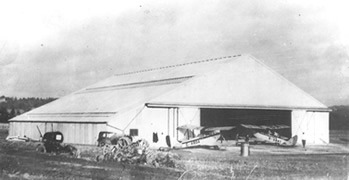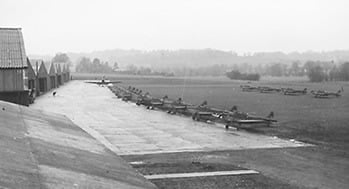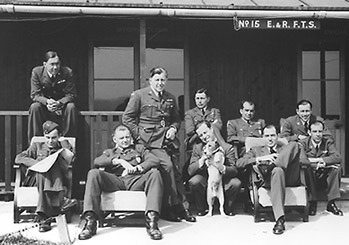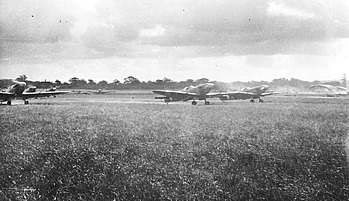
Redhill Aerodrome commenced operations in 1934 to accommodate the original Redhill Flying Club. Imperial Airways started to use it as an alternate to the then London airport at Croydon.

No. 15 EFTS (Elementary Flight Training School) was formed at RAF Redhill Surrey on 3rd July 1937. The first aircraft allocated were a few tired DH 60 Gipsy Moths and later two Hawker Harts were added to the Squadron, finally being replaced by Miles Magisters sometime in 1938. The Squadron had amassed 28 Magisters, 15 Hart variants, 4 Fairy Battles and 3 Avro Ansons. When war finally broke out in September 1939 the Squadrons aircraft were ferried out, but returned to resume training at Redhill between 11th September and 6th November 1939.
On the 1st March 1940 a course was started for the testing & grading of Polish airmen. Each Pilot flew 10 hours in Magisters and 15 hours in Battles. Towards the end of May 1940 the skies over southern England began to darken as aerial activity grew at a steady rate. After the Dunkirk evacuation of the B.E.F. from France No. 15 EFTS evacuated RAF Redhill & moved further North to Carlisle.
-

Miles Magisters & Fairey Battle -

Polish Pilots of No. 15 E & R FTS – Redhill 1939/40
On the 3rd June 1940 No. 16 (Army Co-operation) Squadron arrived with their Westland Lysanders but they did not stay for long. Redhill remained inactive for much of the Battle of Britain until the arrival of No. 600 Squadron with it’s Blenheim IVfs and the new radar equipped Beaufighter 600 Sqn. carried out night fighter patrols until moving out in October 1940 to be replaced by No. 219 Squadron with it’s Blenheims and Beaufighters where they also flew many night fighter operations until finally moving out by 10th December 1940.
A perimeter track was constructed round the airfield (which remained grass-surfaced) and from this led taxi-tracks to eight Blister hangers and a dozen or so dispersal pens.
On 1st May 1941 Redhill became a satellite aerodrome for RAF Kenley and No 1 Squadron Hurricane’s moved in. No 1 Squadron had been employed as a specialist night fighter unit and on the night of 10th May they shot down no less than six enemy aircraft! No. 1 Squadron stayed at RAF Redhill until 1st June when they were replaced by Hurricanes of No. 258 Squadron as part of the Kenley Wing.

From May 1941 to January 1944 numerous fighter Squadrons flew Rodeo fighter sweeps over France from RAF Redhill, all except six were equipped with Spitfires (see movement table). Circus operations covering Boston aircraft were also flown from Redhill during this time. No. 485 Squadron during their stay at Redhill destroyed 14 enemy aircraft, plus 8 probable’s& nine damaged. On the 20th March 452 was replaced by No. 457 Australian Squadron led by Sqn Ldr. M. Brothers DFC. On 13th may 602 Squadron led by Sqn. Ldr. B.E. Finucane moved in together with 457 Sqn. to form the Redhill wing. Later that month Canadian 402 Squadron moved in to replace 457. 602 moved to Peterhead and was replaced by No. 611 Squadron with their Mk IX Spitfires and flew many Rhubarb operations against railways and other communication systems. Later No. 350 Belgium Squadron moved to Redhill flying convoy patrols. The airfield was used as an advanced air base for the attack on Dieppe in August 1942 and for this purpose, housed Nos 350 Squadron, 611 Squadron, 303 Squadron, 310 Squadron and 312 Squadrons. During the Dieppe raid 24 enemy aircraft had been destroyed by the Redhill Squadrons! By this time over 800 personnel were at Redhill and the huge piles of bicycles outside mess halls were common sights. The squadrons left Redhill on the 18th September and airfield was used as an unofficial emergency landing ground with two B-17’s and a B-24 landing on 23rd short of fuel.
After departure of the fighter Squadrons, Redhill housed No. 83 Group Support Unit and various second-line squadrons. In October No. 231, 400 and 414 Squadrons with their Mustang I’s part of 39 Reconnaissance Wing 2nd TAF. In line with the policy of the 2nd TAF, No. 83 Support Group was formed at Redhill from 1st March, Nos 405 and 410 Aircraft Repair Flights arriving from Detling to join with Nos 403 and 409 already at the airfield. They were soon joined by No, 3207 Servicing Commando pre pairing new aircraft, mainly Typhoons for squadron service. The airfield now became an important platform for build up of supplies and equipment for the preparation of D-Day. Prior to D-Day over two hundred fighter aircraft were based at Redhill to support the invasion forces. With the threat of the V1 ever closer Redhill became No. 24 Balloon Centre and landings were forbidden. The Avro Ansons of No. 1310 Flight were here for a short time during 1944. No 116 Calibration Squadron to Redhill from Gatwick on September 5th 1944. The unit was equipped with De Thailand Tiger Moths, Airspeed Oxfords and Hawker Hurricanes and its main task was calibration of radar used by Anti Aircraft units and checks of predictor equipment. In December the airfield became the base for the Canadian Casualty Evacuation Unit whose Dakotas flew in day and night with wounded being transported to Smallfields Hospital, they moved out in the New Year. On January 20th 1945 it was joined by No. 287 Squadron (also from Gatwick), this was an anti-aircraft co-operation squadron flying Airspeed Oxfords, Spitfires and Typhoon aircraft. On the 15th January 1945 Redhill became a satellite for Biggin Hill and in February Nos 166 and 287 were the last squadrons to occupy the airfield.
At the end of WW2 Redhill was used for the storage of unused bombs, which were finally cleared by the end of 1946. On April 1st 1948, No. 15 Reserve Flying School was formed at Redhill. Tiger Moths were used as basic trainers for pilots and Ansons for Navigational training. The RFS also used a few Oxfords and towards the end of its service life, it received De Havilland Chipmonks. The increasing complex of modern aircraft resulted in closure of the Reserve Training Programme in 1954 and No. 15 RFS was dis-banded on June 20th 1954.
Today Redhill is a busy airfield with light aircraft and helicopters flying in the now peaceful skies.
Squadrons:
No. 15 ERFTS
Magister/Hart
July. 37 – Sept. 39
No. 15 Polish Grading School
Fairey Battles
Mar. 40 – Jun. 40
No. 16 Squadron
Lysander 1
Jun. 40
No. 600 Squadron
Blenheim IVfs & Beaufighter IFs
Sept. 40
No. 219 Squadron
Blenheim IVfs & Beaufighter IFs
Oct. 40
No. 440 Squadron
Lysander III
Mar. 41
No. 1 Squadron
Hurricane IIB
2.5.41 – 1.6.41
No. 258 Squadron
Hurricane IIA
1.6.41 – 15.6.41
No. 485 Squadron
Spitfire IIA
Jul. 40 – Oct. 41
No. 452 Squadron
Spitfire VB
21.10.41 – 17.3.42
No. 602 Squadron
Spitfire VB
14.1.42 – 4.3.42
No. 457 Squadron
Spitfire VB
23.3.42 – 31.5.42
No. 340 Squadron
Spitfire VB
1.4.42 – 7.4.42
No. 402 Squadron
Spitfire VB
May – Aug. 42
No. 602 Squadron
Spitfire VB
13.5.42 – 17.7.42
No. 308 Squadron
Spitfire IIA
1.7.42 – 7.7.42
No. 312 Squadron
Spitfire VB
1.7.42 – 8.7.42
No. 611 Squadron
Spitfire VB
20.7.42 – 27.7.42
No. 353 Squadron
Spitfire VB
31.7.42 – 7.9.42
No. 611 Squadron
Spitfire V
1.8.42 – 23.9.42
No. 303 Squadron
Spitfire VB
15.8.42 – 20.8.42
No. 310 Squadron
Spitfire VC
16.8.42 – 20.8.42
No. 312 Squadron
Spitfire VB
16.8.42 – 20.8.42
No. 416 Squadron
Spitfire VB
Aug. 42 – Feb 43
No. 350 Squadron
Spitfire VB
15.9.42 – 23.9.42
No. 412 Squadron
Spitfire VB
23.9.42 – 1.11.42
No. 421 Squadron
Spitfire VB
Mar. 43 – May 43
No. 411 Squadron
Spitfire VB
Apr. 43 – Aug. 43
No. 401 Squadron
Spitfire VB
May 43 – Aug. 43
No. 412 Squadron
Spitfire VB
14.7.43 – 7.8.43
No. 66 Squadron
Spitfire XI
10.8.43 – 13.8.43
No. 504 Squadron
Spifire VC
14.8.43 – 19.9.43
No. 131 Squadron
Spitfire VC
16.8.43 – 17.9.43
No. 231 Squadron
Mustang I
15.10.43 – 15.1.44
No. 400 Squadron
Spitfire XI
Dec. 1943
No. 414 Squadron
Mustang I
15.10.43 – 2.11.43
No. 116 Squadron
Anson I
Sept 1944
No. 287 Squadron
Tempest V
Jan 1945
Types:
Gipsy Moth
Hawker Hart
Miles Magister
Fairey Battle
Avro Anson
Hurricane
Blenheim
Beaufighter
Spitfire
Mustang 1
Tempest
C-47 Dakota
Nationalities:
British
Polish
New Zealand
Norwegian
Canadian
Czech
Belgium
Australian
French